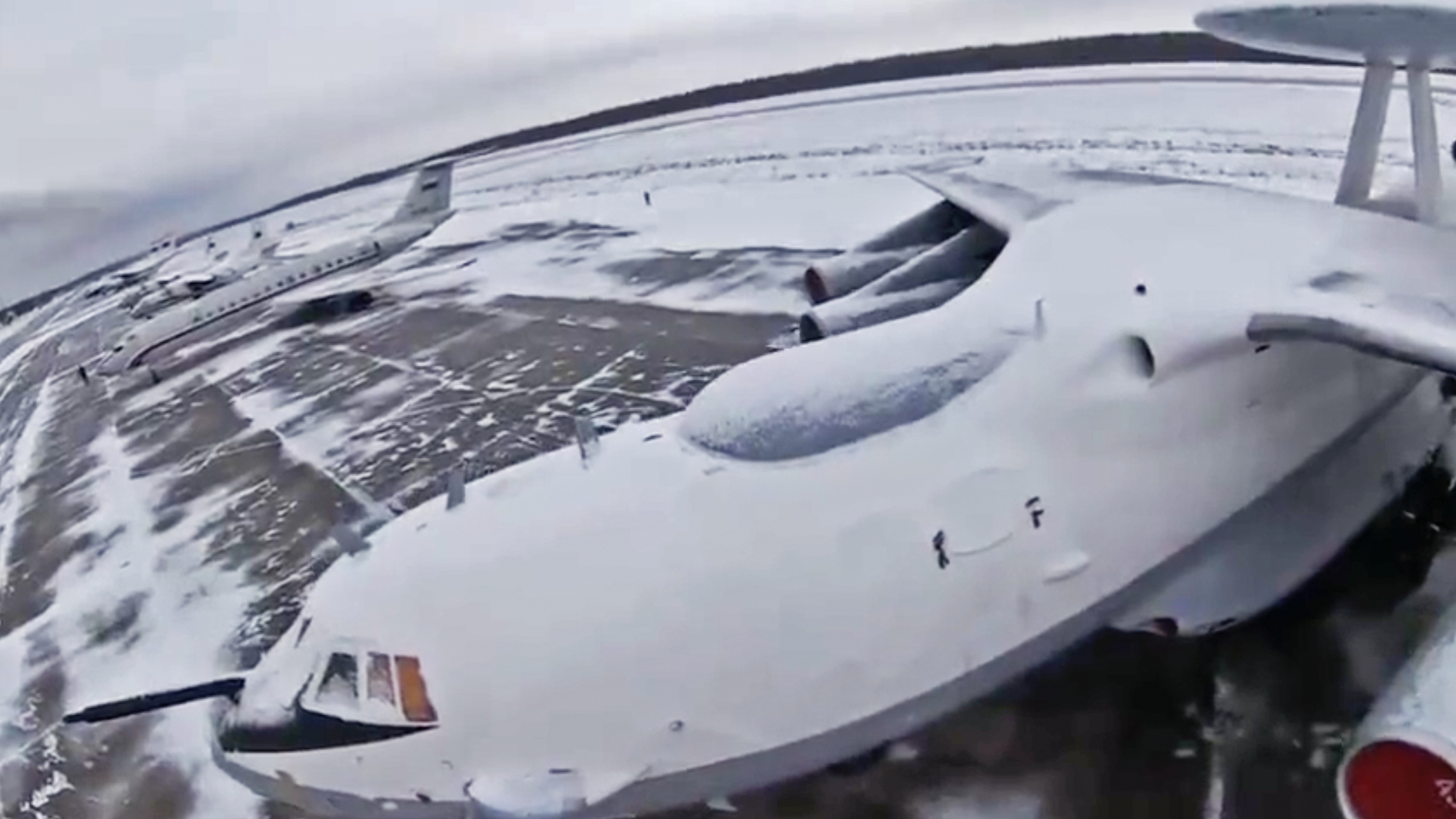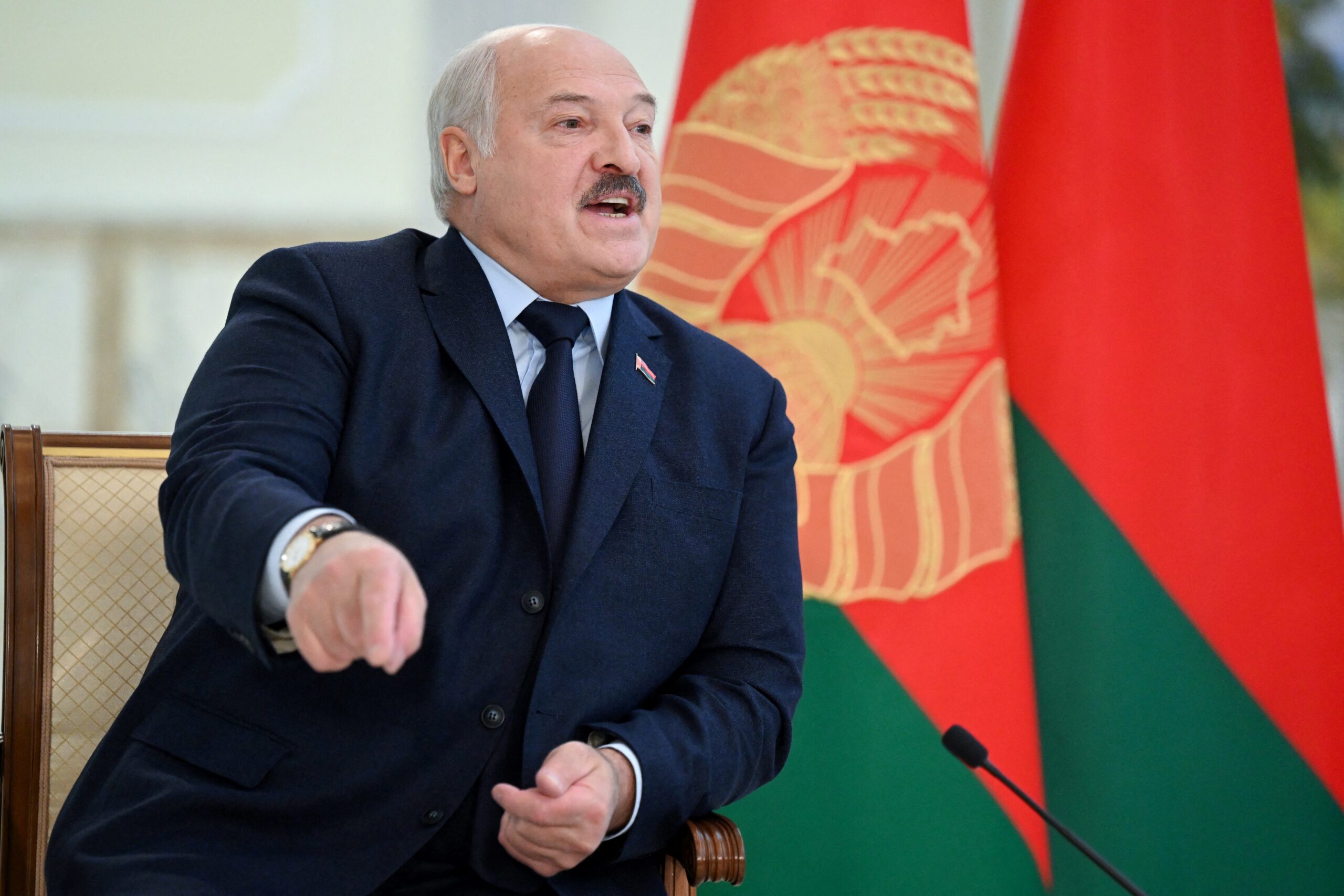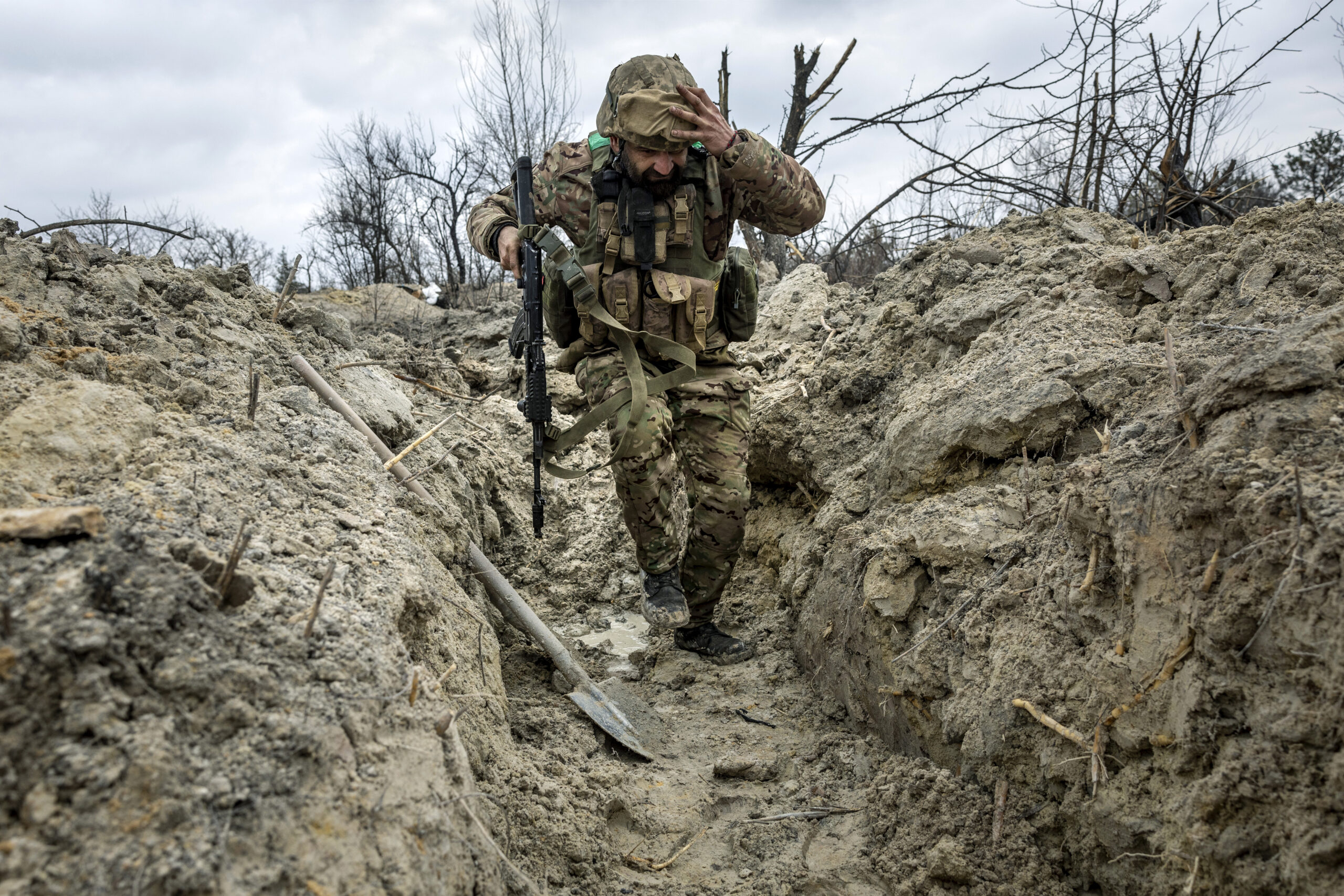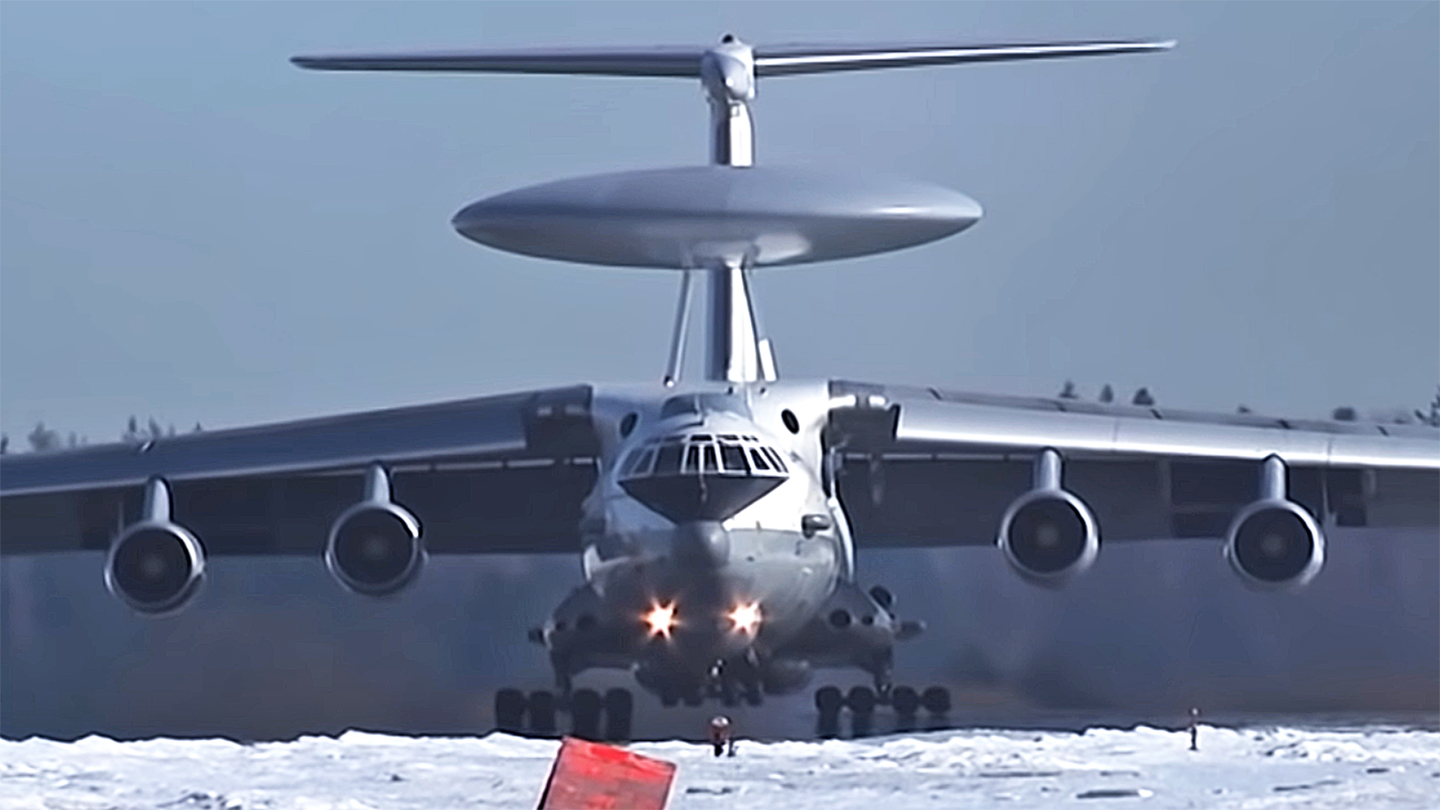Belarusian leader Alexander Lukashenko has claimed that more than 20 people have been arrested following a drone attack on a Russian A-50 Mainstay airborne early warning and control (AEW&C) aircraft at Machulishchy Air Base, Belarus, late last month. Lukashenko confirmed that an attack using a “small drone” did indeed take place but said the radar plane suffered only superficial damage.
“The security service of Ukraine, the leadership of the CIA, behind closed doors, are carrying out an operation against the Republic of Belarus,” Lukashenko said, according to the country’s official news agency, Belta. “A terrorist was trained,” he added, referring to one of those suspects now said to have been arrested.
As well as the claimed terrorist suspect, described as a dual Russian-Ukrainian national, other individuals said to have been accomplices are now in custody, according to Lukashenko.

BYPOL, an organization of Belarusian military dissidents opposed to the Lukashenko government, claimed to have used two drones to attack the A-50, damaging it in two critical places — its radome and its upper forward fuselage area — on February 26.
Subsequently, BYPOL released a video showing what it said was one of its drones landing on the A-50’s radar dome, followed by another video that showed a drone touching down on the forward fuselage. In both cases, the footage is inconclusive when it comes to confirming whether the claimed drone attack actually caused any damage to the radar plane.
The first video shows a drone landing on the radar dome of the Russian A-50:

The second video shows a drone landing on the forward fuselage SATCOM dome of the same A-50:
While officials in Belarus and Russia refuted the dissidents’ claims that the A-50 was blown up, Lukashenko now admits that the attack resulted in at least a limited amount of damage to the aircraft. This may support claims that the jet was subsequently flown to Taganrog in Russia, to undergo repairs, as well as the apparent changes in appearance to the forward-fuselage satellite communications (SATCOM) dome, which would seem to be consistent with this area having been repaired or its cowling swapped out.

The latest satellite imagery obtained by The War Zone reveals that, as of yesterday, the A-50 was no longer at Machulishchy. Since the weather was overcast in the previous days, it’s possible that the aircraft actually returned to Russia days before then. Although we cannot say for sure, this might also suggest that temporary repairs were made to the aircraft first, but that it’s now returned to Russia for more extensive work and will be replaced by another example. It could also be a pre-planned swap with another A-50.
The Ukrainian Foreign Ministry has denied that the country was involved in the drone strike at Machulishchy.
“It is clear that this is another attempt to create an artificial threat from Ukraine for the sake of justifying [Belarusian] support for Russia’s aggression,” Ukrainian Foreign Ministry spokesperson Oleg Nikolenko said.
Meanwhile, Oleksiy Danilov, the secretary of the National Security and Defense Council of Ukraine, has stated that the A-50 was severely damaged and that the attack was the work of Belarusian partisans.
“A ‘thing’ happened in Machulishchy with the Russian plane, which was aiming missiles at our cities. Thanks to this plane, they were killing our children, women, and attacking civilians. According to our information, Belarusian partisans severely damaged this plane,” Danilov said.
Before we head into the latest news from Ukraine, The War Zone readers can get caught up on our previous rolling coverage here.
The Latest
A report in the New York Times citing unnamed U.S. intelligence officials claims that a pro-Ukrainian group may have carried out the attack on the Nord Stream pipelines last year, an incident that we reported on at the time, and which had been widely blamed on Russia.
The German government says it has taken note of the New York Times report but that its own investigation into the pipeline attack has not yet reached a definitive conclusion.
Kyiv has strenuously denied the latest allegations. Mykhailo Podolyak, a senior presidential aide, said that Ukraine was “absolutely not involved” in the attacks and has no information about what happened.
In the meantime, Denmark, Germany, and Sweden are all continuing their investigation into what happened, with a spokesperson for the German government stating: “The Federal Public Prosecutor has been investigating the matter since the beginning of October 2022. It thus has sovereignty over the procedure.”
As fighting continues around the eastern Ukrainian city of Bakhmut, the leader of the Wagner Group private military company, Yevgeny Prigozhin, has claimed that between 12,000 and 20,000 Ukrainian troops remain in the city — together with around 4,000 civilians, according to separate reports.
Prigozhin, it seems, is keen to lower expectations around potential Russian victory in the offensive, after Russian Minister of Defense Sergei Shoigu said that capturing Bakhmut could serve as a launchpad for a broader offensive in the east. Shoigu has also said that taking Bakhmut would be fundamental for such an offensive, telling Russian television that “capturing it will allow for further offensive operations deep into the defensive lines of the Ukrainian armed forces.”

Meanwhile, other observers, as we have previously reported, are less convinced of the strategic importance of the city. U.S. Defense Secretary Lloyd Austin recently described Bakhmut as being mainly of symbolic importance and argued that a Russian victory there would not necessarily change the course of the war to any significant degree.
Prigozhin is now urging against “putting the cart before the horse, saying that we have taken Bakhmut and what will happen after.”
“It is very complicated to kill between 12,000 and 20,000 Ukrainian soldiers by tomorrow morning,” Prigozhin added. “Such masters only exist in the depths of the general staff or at Soyuzmultfilm,” he said, with a reference to a Soviet-era cartoon studio. Meanwhile, Western estimates put the number of Russian casualties in the fighting for Bakhmut at between 20,000 and 30,000.
Yesterday we reported that Ukrainian President Volodymyr Zelensky had said Kyiv planned to continue its defense of the city, amid reports that a Ukrainian tactical withdrawal may already have begun. Zelensky reiterated today that “no part of Ukraine… can be abandoned.”
In a statement today, Jan Gagin, an adviser to the Russian-installed leaders in the occupied portion of Donetsk, claimed that Russian forces now control about half of Bakhmut, including all major roads in and out of the city.
“Our artillery, our equipment, and our troops are already in the city,” Gagin told TASS. “They control almost half of Bakhmut. I do not rule out attempts [by Ukrainian forces] to break through in order to try to keep it, and breakouts from the city itself, there is a chaotic retreat of small groups.”
Ukraine today identified the soldier who was shot dead by Russian forces after being captured as a prisoner of war as 40-year-old Tymofiy Mykolayovych Shadura.
A graphic 12-second clip first appeared on Telegram yesterday before being widely shared on social media. In the video, the detained soldier, in Ukrainian uniform, was seen standing in a trench, unarmed, smoking a cigarette. After saying “Glory to Ukraine,” he was then apparently killed in a hail of automatic gunfire.
Assigned to the 30th Independent Mechanized Brigade, Shadura was posted missing in action during fighting around Bakhmut early last month.
President Zelensky has bowed to “find the murderers” responsible for Shadura’s killing.
Other prisoners of war have been in the news today, with the announcement that 130 captured Ukrainian soldiers have been returned home following an exchange with Russia.
According to Andriy Yermak, the head of the Office of the Ukrainian Presidency, “We managed to return home 130 of our people… I am proud of the entire team that worked long and hard on this exchange.”
The Russian Ministry of Defense confirmed that 90 Russian prisoners of war were returned by Ukraine.
Some interesting information about Ukraine’s little-publicized cross-border raids into Russia became available today, with the funeral for four individuals who were killed during an operation on Russian territory.
The four — one of them a teenager — had been taking part in a sabotage mission in Russia’s southern Bryansk region in December, when they were killed in one of many missions that have been conducted by Ukraine in the border regions.
The individuals were apparently part of the Bratstvo, or Brotherhood, battalion, established after the party of the same name. At the funeral in Kyiv, Brotherhood party leader Dmytro Korchynsky provided the following details: “[They were in] one of the reconnaissance sabotage groups of Bratstvo that take part in raids at the enemy’s rear, both in the occupied territories… and on Russian soil. They were killed during one of those raids.”
Russia’s FSB security service said that it had killed the men, after finding them armed with rifles and explosives, with the bodies reportedly being returned to Ukraine this month.
A Ukrainian official today provided new details about the situation in the Luhansk region, Ukraine’s easternmost province, which is mainly occupied by Russian forces.
The governor of the region, Serhiy Haidai, described the situation in Luhansk as “stable and controlled.” He said that the Russians have “pulled back to replenish their reserves” but that attacks in the direction of Bilohorivka and Kreminna have recently increased.
“Freshly mobilized Russians are demotivated when their commanders abandon them when they see the real number of losses of the Russian Army, as well as the conditions in which they found themselves at the front,” Haidai said.
He added: “The Russians in the occupied territories treat the local population even more aggressively — they take out their anger on civilians due to the lack of success at the front.”
Ukraine appears set to receive more Western tanks this week after Poland said it would deliver another 10 Leopard 2 main battle tanks. These are part of the 14 examples that Warsaw had already promised to send to Ukraine. The first four Polish-supplied Leopard 2s are already in the country and Poland has also now offered to launch a repair and overhaul facility for the tanks in Ukraine.
However, the Polish Ministry of Defense corrected previous unconfirmed reports that Patriot air defense systems were already in Ukraine.
There are unconfirmed reports that Russian-occupied Crimea has again come under Ukrainian attack, although the Russian-installed governor of Sevastopol today denied this. Reportedly, explosions were heard near Belbek Air Base, a key hub for Russian Aerospace Forces and an area that has come under attack previously.
“The public is again writing about some kind of explosion near the airfield,” Sevastopol’s governor Mikhail Razvozhaev posted to Telegram. “This is a lie. Ship crews are training… Everything is calm in the city.”
That’s it for now. We’ll update this story when we have more to report.
Contact the author: thomas@thedrive.com
